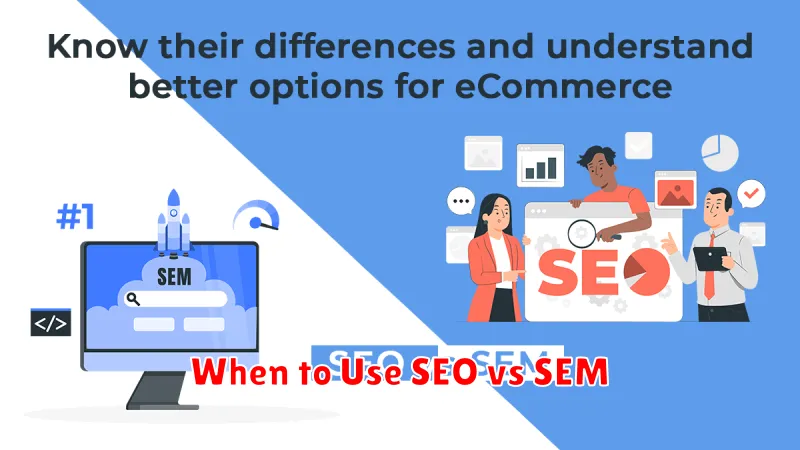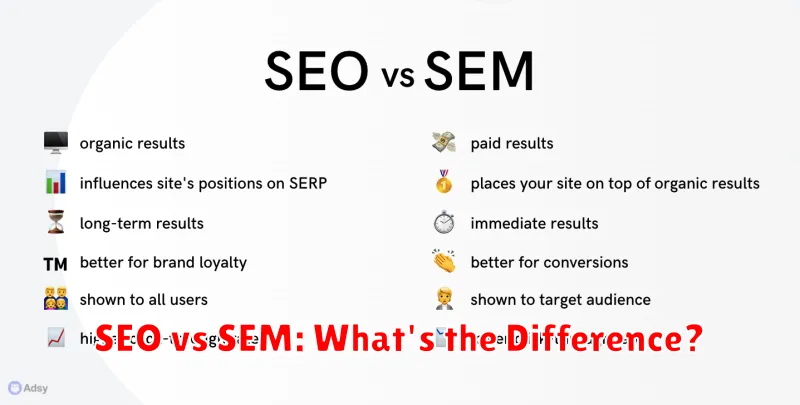In the ever-evolving digital landscape, driving traffic to your website is paramount to success. Two prominent strategies, Search Engine Optimization (SEO) and Search Engine Marketing (SEM), often dominate discussions about online visibility. Understanding the distinctions between these approaches is crucial for crafting a comprehensive and effective digital marketing strategy. This article delves into the core differences between SEO and SEM, highlighting their respective strengths and weaknesses to help you determine the optimal path for achieving your online objectives. We’ll explore how each method contributes to improved search engine rankings, increased website traffic, and ultimately, business growth.
While both SEO and SEM aim to enhance your website’s visibility on search engine results pages (SERPs), they employ distinct methodologies. SEO focuses on organic, or unpaid, strategies to improve rankings, while SEM primarily leverages paid advertising to achieve immediate visibility. Choosing the right approach depends on your specific goals, budget, and timeline. This article will provide a clear comparison of SEO vs. SEM, empowering you to make informed decisions about your digital marketing investments and maximize your return on investment (ROI).
Defining SEO and SEM
Search Engine Optimization (SEO) is the practice of increasing the quantity and quality of organic traffic to your website through non-paid search engine results. It focuses on optimizing your website content and structure to rank higher in search engine results pages (SERPs) naturally. Key elements of SEO include keyword research, content creation, technical optimization, and link building. Effective SEO aims to attract users actively searching for information related to your offerings.
Search Engine Marketing (SEM) is a broader digital marketing strategy that encompasses all efforts to increase visibility in search engines. This includes both paid and organic strategies. While SEO falls under the umbrella of SEM, the term SEM most commonly refers to paid advertising on search engines. This involves bidding on keywords related to your business and paying for your website to appear at the top of SERPs as sponsored ads. SEM provides immediate visibility and allows for precise targeting of specific demographics and interests.
How They Complement Each Other
While distinct, SEO and SEM strategies can work synergistically to maximize online visibility. SEO provides the foundation for long-term, organic growth by focusing on website optimization and earning high rankings in search results. This builds credibility and attracts consistent, free traffic.
SEM, with its paid campaigns, delivers immediate visibility and targeted reach. It’s particularly effective for new websites or product launches where organic rankings haven’t yet been established. SEM can also be used strategically to boost visibility for highly competitive keywords where organic ranking is challenging.
Using SEM data can inform SEO strategy. By analyzing which keywords are driving conversions in paid campaigns, you can identify valuable keywords to prioritize in your organic SEO efforts. Furthermore, SEM can drive traffic to content optimized for specific keywords, potentially improving organic rankings over time.
Integrating both approaches allows businesses to capture a wider audience. SEO attracts users searching organically, while SEM reaches those actively clicking on ads. This combined approach creates a stronger online presence and reinforces brand visibility.
When to Use SEO vs SEM

Deciding between SEO and SEM depends on your specific goals and resources. SEO is a long-term strategy that builds organic visibility over time. It’s best for establishing brand authority and capturing consistent, free traffic from search engines. Choose SEO when you have the time and resources to invest in content creation, technical optimization, and link building. Consider SEO essential for sustained online success.
SEM, specifically paid search advertising, delivers immediate results. It’s ideal for short-term campaigns, product launches, or when you need to quickly drive traffic to your website. Opt for SEM when you need rapid visibility, have a specific budget allocated for advertising, and are comfortable managing paid campaigns. SEM is particularly effective for targeting specific keywords and demographics.
Often, a combined approach yields the best results. Leveraging both SEO and SEM allows you to maximize your reach and cover both immediate and long-term marketing goals. For example, use SEM to boost visibility for new products while simultaneously building organic presence through SEO.
Cost and Time Considerations
Cost is a significant differentiating factor between SEO and SEM. SEO is generally considered a long-term strategy with organic traffic acquisition being a key goal. While there aren’t typically direct costs for clicks, SEO involves investments in content creation, technical optimization, and potentially SEO tools or consultant fees. SEM, on the other hand, involves a direct cost per click through advertising platforms. Budgets can be closely managed, allowing for precise control over spending.
Regarding time, SEO results typically take longer to materialize. Building organic rankings requires consistent effort and patience. SEM, however, can deliver immediate visibility. As soon as your campaigns are launched and approved, your ads can start appearing in search results. This makes SEM a valuable tool for quick wins and short-term campaigns.
Short-Term vs Long-Term Results
A key difference between SEO and SEM lies in the timeframe for results. SEM, with its paid advertising campaigns, delivers immediate visibility. As soon as your campaigns are launched and approved, your website appears in search results. This makes SEM ideal for businesses seeking rapid traffic and conversions, especially for product launches or time-sensitive promotions.
SEO, on the other hand, is a long-term strategy. Building organic rankings takes time and consistent effort. Factors like keyword optimization, content creation, and link building gradually improve your website’s authority and search engine ranking. While the results aren’t instantaneous, they are more sustainable and often lead to higher quality traffic with stronger user engagement over time. SEO is best suited for businesses looking to establish a strong online presence and build a loyal customer base organically.
Keyword Research for Each Strategy
Both SEO and SEM rely heavily on keyword research, but their approaches differ slightly. SEO keyword research focuses on identifying relevant keywords that users organically search for to find information or products related to your business. This involves understanding search intent, analyzing search volume, and considering keyword difficulty.
SEM keyword research, while still considering organic search behavior, is more directly tied to paid advertising campaigns. It emphasizes keywords that drive conversions and offers a greater ability to experiment with broader match keywords due to the controlled environment of paid search. Cost-per-click (CPC) becomes a critical factor in SEM keyword selection, requiring careful analysis of keyword value and potential return on investment (ROI).
Integrating SEO and SEM
While distinct strategies, SEO and SEM offer a powerful synergy when integrated. Combining organic and paid efforts creates a comprehensive online marketing approach. SEM can provide immediate visibility while SEO builds long-term, sustainable traffic.
One key integration tactic involves using SEM data to inform SEO strategy. Analyzing paid search data reveals valuable insights into high-performing keywords and user search intent. This information can be leveraged to optimize website content and target relevant keywords organically.
Conversely, a strong SEO foundation amplifies SEM campaigns. Websites with robust organic presence often enjoy higher quality scores in paid search, resulting in lower costs and better ad positioning. This integration creates a virtuous cycle, where each strategy benefits the other.
Tracking Metrics Differently
While both SEO and SEM aim to drive traffic and conversions, they track key performance indicators (KPIs) differently. SEO focuses on organic search visibility. Important metrics include organic keyword rankings, organic traffic volume, and domain authority. Tracking these metrics helps assess the effectiveness of long-term SEO strategies.
SEM, being primarily paid advertising, centers around campaign-specific metrics. Click-through rate (CTR), cost per click (CPC), and conversion rate are crucial for evaluating campaign performance and return on investment (ROI). SEM data offers immediate insights into campaign effectiveness and allows for quick adjustments.
Understanding the distinct metrics for SEO and SEM is essential for accurate performance analysis and informed decision-making. Both strategies offer valuable data, but their focus and interpretation differ significantly.
Tools for Managing Both
While SEO and SEM require distinct approaches, several tools assist in managing both strategies. These tools offer comprehensive features that streamline workflows and provide valuable data insights.
Google Analytics is a cornerstone for both SEO and SEM. It provides in-depth data on website traffic, user behavior, and conversion rates. This data helps optimize both organic search visibility and paid campaign performance.
Google Search Console focuses primarily on organic search, offering insights into website indexing, crawl errors, and keyword rankings. This information is crucial for improving SEO performance and identifying technical issues impacting website visibility.
SEMrush and Ahrefs are comprehensive SEO and SEM tools. They offer keyword research, competitor analysis, site auditing, and backlink tracking. These tools provide valuable insights for improving both organic and paid search strategies. They also enable tracking keyword rankings and identifying opportunities for improvement.
By leveraging these tools, marketers can effectively manage both SEO and SEM, gaining a holistic view of their online presence and maximizing their overall marketing ROI.
Choosing the Right Balance
Finding the optimal mix of SEO and SEM depends heavily on your specific business objectives, budget, and timeline. SEO is a long-term strategy that requires ongoing effort and patience to see significant results. It builds organic visibility and establishes credibility over time, ultimately leading to a sustainable stream of organic traffic. However, it doesn’t offer immediate results.
SEM, on the other hand, provides immediate visibility and allows for precise targeting, which is ideal for quick wins and promoting specific products or services. It’s particularly effective for time-sensitive campaigns or product launches. The downside is that it requires continuous ad spend to maintain visibility, and traffic stops when the budget runs out.
Many businesses find that an integrated approach leveraging both SEO and SEM yields the best results. SEM can drive initial traffic and generate immediate leads while SEO efforts are maturing. As organic rankings improve, reliance on SEM can be strategically adjusted, allowing for a flexible and adaptable marketing strategy.

